About Doug
Doug Purdon was born in Toronto, Ontario. He is a full-time painter, teacher and writer. He is a graduate of the Ontario College of Art and an elected member of the Society of Canadian Artists and Ontario Society of Artists. He currently lives in Toronto with his wife, the writer Rosemary Aubert.
He exhibits his work in galleries in Canada, the US and the UK and his paintings are in many private and corporate collections, including The Toronto Public Library, The City of Toronto, The Arts and Letters Club of Toronto, Sears Canada, and The Mystic Seaport Museum, Mystic CT, where his painting Tugboat Alley was awarded the Museum Purchase Award in 2005. A major retrospective of his work was held in October 2007 at the Arts and Letters Club of Toronto.
Doug believes that artists should continue the tradition of passing on their skills and knowledge to other artists and does this through his workshops, seminars and writing. He currently teaches courses at Loyalist College, Belleville, Ontario; Bridgewater Retreat, Tweed, Ontario; and the School of Continuing Studies, University of Toronto and in workshops for art associations across Canada.
While he paints his native Ontario, he also enjoys travelling to different locations and has painted in Scotland, England, France, and the American Southwest and on the eastern and western seaboard of North America. He is represented by Studio 737, Tweed, Ontario; Arnold Fine Art, Newport RI; and the Gallery at Mystic Seaport, Mystic CT.
For the past eleven years Doug has been the Educational Advisor for Winsor & Newton in Canada. In that capacity he visits colleges and universities demonstrating the working properties of artist’s materials, their correct use and safe working practices. Winsor & Newton has arranged for him to visit major art museums including The Tate, National Gallery of Art Washington and to meet with curators and conservators to discuss the technical and historical aspects of painting and materials. He incorporates the knowledge of painting techniques and proper working practices that he has learned from these visits into his teaching programs.
To learn more about Doug and view more of his work, please visit his website by following the link below:
http://www.dougpurdon-artist.com/
‘Breaking Surf – Brenton Point’ – Oil Painting Tutorial
The Block In
Inspiration for my studio paintings comes from plein air studies, drawings and photographs, which have been done on sight. Depending on the complexity of the subject, I sometimes do a small oil study first. This painting will be a study for a larger work.
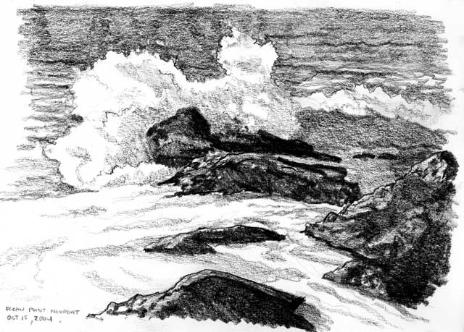
I first block in the painting loosely with Alkyd paint. Alkyd is fast drying oil paint that will be dry enough for me to paint over in 18 – 24 hours. I use it in the early stages of a painting to speed things up. NEVER use alkyd on top of traditional oils as serious technical problems can occur. Don’t get caught up in details when blocking a painting in; only be concerned with the large shapes and overall composition. There is plenty of time to add details later. When the Alkyd block-in is dry I give the canvas a thin stain of Raw Sienna Alkyd to tone the canvas.
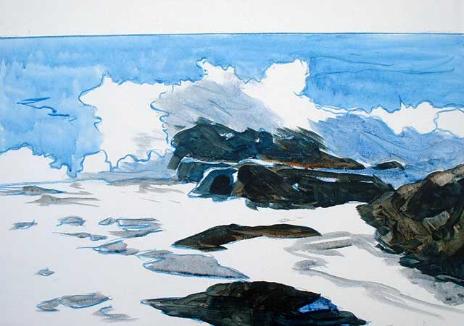
The Under-Painting
Once the stain is dry I start working on the under-painting. During this stage paint is applied thinly, but I don’t use a lot of medium or thinner at this point. I prefer to take advantage of the ability of oils to be brushed out. This keeps this paint layer ‘lean’. I will be using more medium in the following layers. If oil paint is over thinned it is difficult to work with and the colours lose their brilliance.
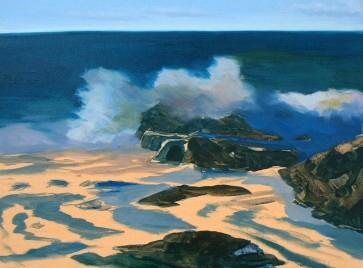
The sky and background water will be close to completion when I finish this stage, but I keep the middle and foreground areas darker. In some areas I am setting up colours that will be enhanced by glazing later. Zinc white is used for mixing colours in the foreground as it is more translucent and has less strength than Titanium and will not overpower subtle colours.
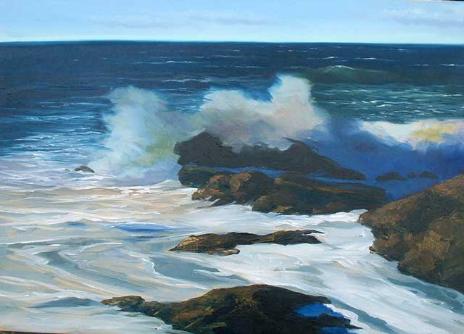
Finishing the Painting
I add detail and adjust the colours and values that were established during the under painting. To achieve the effect of light on the spray, the whites in the rest of the painting are kept darker and cooler. Titanium White is a cold white so I warm it up with a small amount of Cadmium Yellow and Orange. When paint is dry glazes of Alizarin Crimson, French Ultramarine Blue, Permanent Sap Green and Perylene Black are applied to adjust colour and value. I start to refine the patterns of foam in the foreground and add highlights to the rocks.
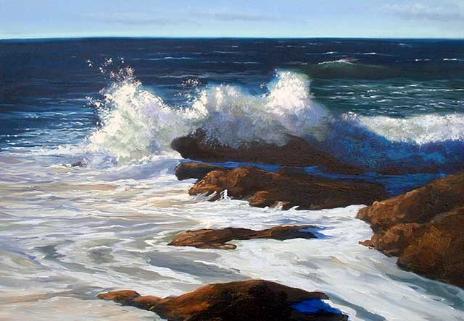
As the painting progresses more layers of transparent, translucent and opaque colours are added to the rocks, water and foam.
When the oil painting is finished it is signed and put away for a week or so. Then I take a final look to see if there are any adjustments needed and make any changes if required.
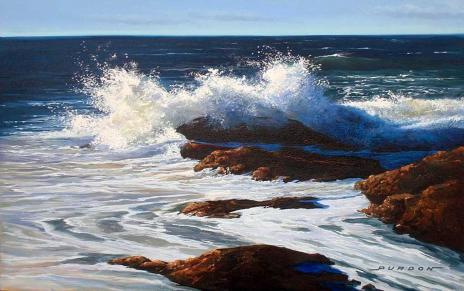
One of the reasons I chose to do a study for the larger painting was that I wanted to experiment with some of the new pigments that have recently become available. Most of these new pigments are very transparent and are excellent for glazing. Ten colours were used in the initial stages of the painting. Two of these colours however, Cadmium Yellow and Orange were only used to warm the whites. In the early stages of a painting I try to limit the number of colours used so as to avoid muddy mixtures.
ALKYD COLOURS USED FOR BLOCKING IN:
- Winsor Blue
- Burnt Umber
- Ultramarine Blue
BASIC PALETTE:
- Winsor Blue (Green Shade)
- Ultramarine Blue
- Burnt Umber
- Yellow Ochre
- Cadmium Yellow
- Cadmium Orange
- Prussian Blue
- Indigo
- Zinc White
- Titanium White
As the painting drew near completion I started to glaze to alter colour and value. Glazing selected areas allows you to achieve the illusion of light coming from within the painting.
ADDITIONAL OPAQUE COLOURS:
- Yellow Ochre
- Cobalt Turquoise
COLOURS USED FOR GLAZING:
- Perylene Black
- Perylene Crimson
- Indian Yellow
- Permanent Sap Green
- Permanent Alizarin Crimson
- Winsor Violet
Leave a Reply